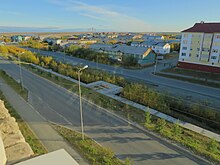Labytnangi
city
|
||||||||||||||||||||||||||||||||||||||||||
|
||||||||||||||||||||||||||||||||||||||||||
|
||||||||||||||||||||||||||||||||||||||||||
| List of cities in Russia | ||||||||||||||||||||||||||||||||||||||||||
Labytnangi ( Russian Лабытнанги , Nenets Лабытнаӈгыт ' , Khanty Лапыт Нангк , "seven larches ") is a city in the autonomous district of Yamal-Nenets ( Russia ) with 26,936 inhabitants (14 October 2010).
geography
The city is located in the northwestern part of the West Siberian lowlands at the height of the Arctic Circle , at the eastern foot of the Polar Urals , about 16 km northwest of the capital of the Salekhard Autonomous Okrug , on the left arm of the Wyl-Posl des Ob .
The city of Labytnangi forms an independent, rajon-free urban district .
history
At the beginning of the 19th century, a camp site for the nomadic Chanten (according to other sources: Nenets ) was built on the site of today's town . Lapyt nangk stands on Khanty for seven larches .
In 1932 a kolkhoz for fishing, hunting and reindeer herding was established . When the construction of the Arctic Circle Railway began in the 1940s, the location was chosen as the western starting point for the planned, but not yet built, crossing of the Ob. In 1948 the line was provisionally completed from the west. In 1952 the place became an urban-type settlement . After the construction of the Arctic Circle Railway was stopped, it took until 1958 for the completed section to be officially opened. At the beginning of the 1960s, Labytnangi became the supply base for the exploration and exploitation of gas condensate deposits . In 1975 the place received city rights.
Population development
| year | Residents |
|---|---|
| 1959 | 5,220 |
| 1970 | 9,190 |
| 1979 | 17,667 |
| 1989 | 31,501 |
| 2002 | 27,304 |
| 2010 | 26,936 |
Note: census data
Culture, education and sights
In Labytnangi there is a branch of the Tyumen Academy of Architecture and Construction, as well as various institutions of the Russian Academy of Sciences .
Economy and Transport
Labytnangi is the center of timber handling and the basis for natural gas production in the area.
The town is the terminus of a 195 km long railway line , which at the station chum from the Pechora railway Kotlas - Vorkuta branches off and crosses the Urals. It is initially the only completed section of the Arctic Circle Railway , which began provisional operations in 1948 and regular operations in 1955. In May 2004 a new station building was opened.
Labytnangi has a river port on the Ob. The city is connected to the neighboring city of Salekhard in summer by ferries and in winter by buses that run over the ice of the frozen Ob.
sons and daughters of the town
- Luisa Noskowa (* 1968), biathlete and Olympic champion
- Julija Makarowa (* 1981), biathlete
- Larissa Kuznetsova (* 1990), biathlete
Penal camp
The penal colony IK-8 Weisser Bär is located near Labytnangi . The Ukrainian film director Oleh Sentsov was also imprisoned there.
Web links
- City administration website (Russian)
- short history of Labytnangi (DOC file; 33 kB; English)
- Labytnangi on mojgorod.ru (Russian)
Individual evidence
- ↑ a b Itogi Vserossijskoj perepisi naselenija 2010 goda. Tom 1. Čislennostʹ i razmeščenie naselenija (Results of the All-Russian Census 2010. Volume 1. Number and distribution of the population). Tables 5 , pp. 12-209; 11 , pp. 312–979 (download from the website of the Federal Service for State Statistics of the Russian Federation)
- ^ Symbolic hunger strike in Russia. Neue Zürcher Zeitung, May 29, 2018, p. 3.
- ↑ Исправительная колония №8 «Белый медведь» (г. Лабытнанги)
- ↑ Hunger for Freedom - The Oleg Sentsow Case . Deutschlandfunk. August 25, 2018. Retrieved January 21, 2019.





